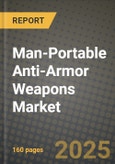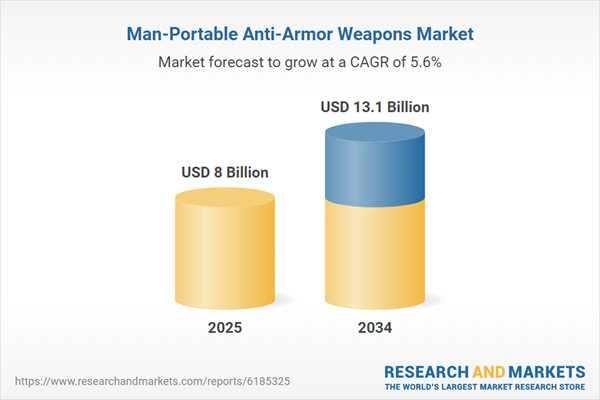The man-portable anti-armor weapons market is a critical component of the global defense and military systems sector. These lightweight, shoulder-fired systems are designed to disable armored vehicles, tanks, bunkers, and low-flying aircraft in combat scenarios. Highly valued for their mobility, precision, and cost-effectiveness, man-portable systems offer strategic advantages in both conventional warfare and asymmetric conflicts. Nations worldwide continue to invest in these systems to equip ground troops with advanced firepower that does not rely on heavy platforms. These weapons include rocket-propelled grenades (RPGs), anti-tank guided missiles (ATGMs), and recoilless rifles. Their demand is particularly high among NATO countries, Asia-Pacific defense forces, and regions with active geopolitical tensions. With growing concerns over armored threats, insurgent tactics, and urban warfare, the market is characterized by rapid innovation in range, accuracy, and warhead technology. As militaries seek to modernize their infantry capabilities, the man-portable anti-armor weapons market remains central to tactical defense planning and procurement priorities.
The man-portable anti-armor weapons market is seeing intensified activity due to global military modernization programs and evolving security dynamics. Ongoing conflicts in Eastern Europe and the Middle East have highlighted the tactical value of these weapons in both defensive and offensive roles. Defense budgets have increased in response, with many countries procuring next-generation systems that incorporate smart targeting, thermal optics, and extended range capabilities. The effectiveness of man-portable systems like the Javelin and NLAW in recent conflicts has driven interest in lightweight, guided anti-armor solutions. Furthermore, private defense contractors and state-run manufacturers are investing in compact designs and dual-purpose payloads that address a variety of battlefield scenarios. Training programs and simulation technologies are also being deployed to ensure operators maximize performance and safety. As a result, contracts and joint ventures are on the rise, creating a competitive yet collaborative development environment. The year 2024 is shaping up as a pivotal period for R&D investments and system upgrades in this sector.
The man-portable anti-armor weapons market is expected to evolve with integration of artificial intelligence, autonomous guidance, and miniaturized components. Future systems will likely combine lightweight portability with highly intelligent targeting systems, enabling greater precision and reduced collateral damage. As geopolitical threats remain fluid and non-state actors grow more sophisticated, defense forces will prioritize agile and scalable weapon systems. Nations in Southeast Asia, Eastern Europe, and Africa are projected to significantly increase imports or local manufacturing capabilities, supported by defense partnerships and offset agreements. Moreover, a renewed focus on modular weapon systems will allow militaries to adapt a single launcher to different warhead types, improving logistical efficiency. Environmental sustainability and compliance with international arms treaties will influence design and production practices. The market will also benefit from cross-industry technology transfers, such as AI from civilian tech sectors. The future of man-portable anti-armor weapons lies in balancing lethal force with precision, versatility, and mobility in a rapidly shifting combat landscape.
Key Insights: Man-Portable Anti-Armor Weapons Market
- Smart guidance systems with thermal and night vision capabilities are becoming standard in new-generation anti-armor weapon models.
- Modular design is emerging, allowing operators to switch out warheads or targeting systems depending on mission requirements.
- Increasing use of man-portable weapons in urban and guerrilla warfare is driving demand for compact, low-collateral-damage solutions.
- Collaborations between global defense companies and local manufacturers are expanding production capacity and localization efforts.
- Virtual and augmented reality-based training simulators are being adopted to enhance operator preparedness and reduce training costs.
- Rising geopolitical tensions and regional conflicts are compelling nations to enhance infantry capabilities with mobile anti-armor systems.
- Military modernization programs are allocating significant budgets toward replacing outdated systems with precision-guided, man-portable weapons.
- Increased demand for lightweight, soldier-operated systems that provide force multipliers without needing heavy vehicles or air support.
- Proven battlefield success of modern systems like the Javelin and Spike ATGM is influencing procurement decisions globally.
- Stringent export controls, high procurement costs, and complex international regulations limit the accessibility of advanced systems for smaller or developing nations.
Man-Portable Anti-Armor Weapons Market Segmentation
By Type
- Anti-Aircraft Missiles
- Rocket Propelled Grenades
- Anti-Tank Rifles
- Recoilless Rifle
By Technology
- Guided Weapons
- Unguided Weapons
By Application
- Homeland Security
- Defense
Key Companies Analysed
- Saab AB (Carl-Gustaf, AT4)
- Rafael Advanced Defense Systems Ltd. (Spike)
- Lockheed Martin Corporation (Javelin JV)
- Raytheon Technologies Corporation
- MBDA Missile Systems
- Northrop Grumman Corporation
- Thales Group
- Nammo AS
- BAE Systems plc
- Kongsberg Defence & Aerospace
Man-Portable Anti-Armor Weapons Market Analytics
The report employs rigorous tools, including Porter’s Five Forces, value chain mapping, and scenario-based modeling, to assess supply-demand dynamics. Cross-sector influences from parent, derived, and substitute markets are evaluated to identify risks and opportunities. Trade and pricing analytics provide an up-to-date view of international flows, including leading exporters, importers, and regional price trends.Macroeconomic indicators, policy frameworks such as carbon pricing and energy security strategies, and evolving consumer behavior are considered in forecasting scenarios. Recent deal flows, partnerships, and technology innovations are incorporated to assess their impact on future market performance.
Man-Portable Anti-Armor Weapons Market Competitive Intelligence
The competitive landscape is mapped through proprietary frameworks, profiling leading companies with details on business models, product portfolios, financial performance, and strategic initiatives. Key developments such as mergers & acquisitions, technology collaborations, investment inflows, and regional expansions are analyzed for their competitive impact. The report also identifies emerging players and innovative startups contributing to market disruption.Regional insights highlight the most promising investment destinations, regulatory landscapes, and evolving partnerships across energy and industrial corridors.
Countries Covered
- North America - Man-Portable Anti-Armor Weapons market data and outlook to 2034
- United States
- Canada
- Mexico
- Europe - Man-Portable Anti-Armor Weapons market data and outlook to 2034
- Germany
- United Kingdom
- France
- Italy
- Spain
- BeNeLux
- Russia
- Sweden
- Asia-Pacific - Man-Portable Anti-Armor Weapons market data and outlook to 2034
- China
- Japan
- India
- South Korea
- Australia
- Indonesia
- Malaysia
- Vietnam
- Middle East and Africa - Man-Portable Anti-Armor Weapons market data and outlook to 2034
- Saudi Arabia
- South Africa
- Iran
- UAE
- Egypt
- South and Central America - Man-Portable Anti-Armor Weapons market data and outlook to 2034
- Brazil
- Argentina
- Chile
- Peru
Research Methodology
This study combines primary inputs from industry experts across the Man-Portable Anti-Armor Weapons value chain with secondary data from associations, government publications, trade databases, and company disclosures. Proprietary modeling techniques, including data triangulation, statistical correlation, and scenario planning, are applied to deliver reliable market sizing and forecasting.Key Questions Addressed
- What is the current and forecast market size of the Man-Portable Anti-Armor Weapons industry at global, regional, and country levels?
- Which types, applications, and technologies present the highest growth potential?
- How are supply chains adapting to geopolitical and economic shocks?
- What role do policy frameworks, trade flows, and sustainability targets play in shaping demand?
- Who are the leading players, and how are their strategies evolving in the face of global uncertainty?
- Which regional “hotspots” and customer segments will outpace the market, and what go-to-market and partnership models best support entry and expansion?
- Where are the most investable opportunities - across technology roadmaps, sustainability-linked innovation, and M&A - and what is the best segment to invest over the next 3-5 years?
Your Key Takeaways from the Man-Portable Anti-Armor Weapons Market Report
- Global Man-Portable Anti-Armor Weapons market size and growth projections (CAGR), 2024-2034
- Impact of Russia-Ukraine, Israel-Palestine, and Hamas conflicts on Man-Portable Anti-Armor Weapons trade, costs, and supply chains
- Man-Portable Anti-Armor Weapons market size, share, and outlook across 5 regions and 27 countries, 2023-2034
- Man-Portable Anti-Armor Weapons market size, CAGR, and market share of key products, applications, and end-user verticals, 2023-2034
- Short- and long-term Man-Portable Anti-Armor Weapons market trends, drivers, restraints, and opportunities
- Porter’s Five Forces analysis, technological developments, and Man-Portable Anti-Armor Weapons supply chain analysis
- Man-Portable Anti-Armor Weapons trade analysis, Man-Portable Anti-Armor Weapons market price analysis, and Man-Portable Anti-Armor Weapons supply/demand dynamics
- Profiles of 5 leading companies - overview, key strategies, financials, and products
- Latest Man-Portable Anti-Armor Weapons market news and developments
Additional Support
With the purchase of this report, you will receive:- An updated PDF report and an MS Excel data workbook containing all market tables and figures for easy analysis.
- 7-day post-sale analyst support for clarifications and in-scope supplementary data, ensuring the deliverable aligns precisely with your requirements.
- Complimentary report update to incorporate the latest available data and the impact of recent market developments.
This product will be delivered within 1-3 business days.
Table of Contents
Companies Mentioned
- Saab AB (Carl-Gustaf AT4)
- Rafael Advanced Defense Systems Ltd. (Spike)
- Lockheed Martin Corporation (Javelin JV)
- Raytheon Technologies Corporation
- MBDA Missile Systems
- Northrop Grumman Corporation
- Thales Group
- Nammo AS
- BAE Systems PLC
- Kongsberg Defence & Aerospace
Table Information
| Report Attribute | Details |
|---|---|
| No. of Pages | 160 |
| Published | October 2025 |
| Forecast Period | 2025 - 2034 |
| Estimated Market Value ( USD | $ 8 Billion |
| Forecasted Market Value ( USD | $ 13.1 Billion |
| Compound Annual Growth Rate | 5.6% |
| Regions Covered | Global |
| No. of Companies Mentioned | 10 |









